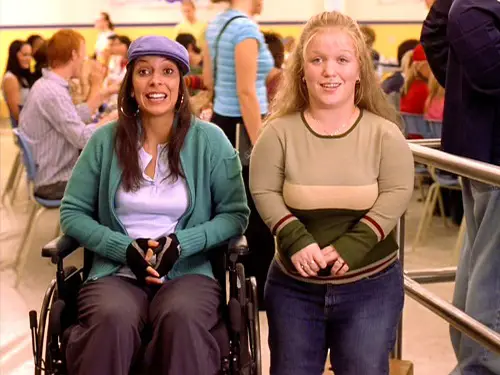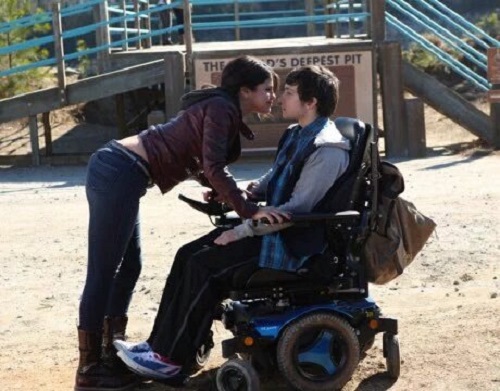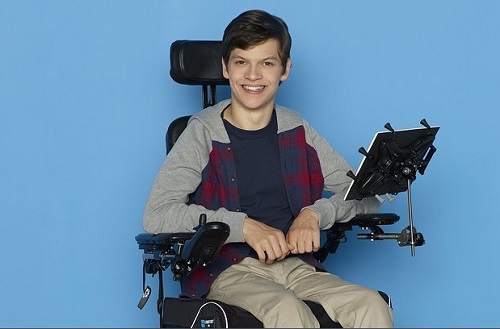
What do you think of how people with disabilities are portrayed in films and on TV?
This is an updated post from our archives exploring how disabled people are represented in films and TV. While Hollywood and the entertainment industry have made strides in inclusivity, many stereotypes and misrepresentations persist. This update includes recent examples of disability portrayal, highlighting progress, areas for improvement, and key discussions around authentic casting and storytelling.
Update for 2025
Breaking Barriers: Race Eberhardt and Strait Undercover
One of the most exciting upcoming releases in 2025 is Strait Undercover, a grassroots indie film featuring a breakthrough performance by Race Eberhardt, a talented actor with Down syndrome. Recently highlighted on The Today Show, Eberhardt is making history as he takes on a leading role in a fun, action-packed adventure.
For years, Hollywood has been slow to cast disabled actors in dynamic, lead roles—especially in action or comedy genres. Strait Undercover defies this trend by not only casting a disabled actor but giving him a character that isn’t defined by his disability. As the film gains traction ahead of its summer release, it stands as proof that representation can be exciting, engaging, and marketable.
Why Race Eberhardt’s Role Matters
Historically, disabled characters in movies have been portrayed through an overly dramatic or pitiful lens, often played by non-disabled actors. Race Eberhardt’s role in Strait Undercover offers a powerful alternative:
- It proves disabled actors can lead films across all genres, not just dramas about disability.
- It challenges outdated Hollywood norms by showcasing an actor with Down syndrome in a role full of action, humour, and energy.
- It sets a precedent for future indie and mainstream filmmakers to cast disabled actors in complex, entertaining roles.
The Future of Disability Representation in Film
The rise of actors like Race Eberhardt signals an industry shift. More and more, audiences are demanding authenticity in storytelling. Following the success of films like CODA and the increased push for diversity in casting, Hollywood has no excuse to ignore disabled talent.
But the responsibility doesn’t just fall on studios and directors—it also falls on audiences. By supporting films like Strait Undercover, viewers send a message that authentic representation is not just necessary—it’s entertaining and valuable.
How You Can Support Inclusive Filmmaking
If you want to see more films like Strait Undercover, here’s how you can help:
- Follow the official website and social media pages to stay updated.
- Attend screenings or stream the film when it’s released.
- Engage in conversations about authentic disability representation online.
- Encourage mainstream media to spotlight indie projects that champion inclusion.
With the buzz surrounding Strait Undercover and Race Eberhardt’s performance, we could be witnessing a turning point for disabled actors in film. Let’s make sure it’s not just a one-time moment, but a movement.
Original post follows
After watching jaw-dropping negativity of disability in a film, our Deputy Editor Shannon Kelly was compelled to write an article exploring the representation of disabled people in films and on TV. Read on to find out her thoughts on a selection of recently featured disabled characters and what their appearance does for society’s view of disabled people.
Representation in the media is important. People from all walks of life deserve to see their stories told on the big or small screen. It is a powerful medium that can either make or break how people feel about themselves and other people around them.
I don’t think I’m alone when I say that the representation of people with disabilities in the media needs massive improvement. The disability community is resilient, loving, powerful and proud. However, TV shows and movies don’t necessarily portray that.
So, I’ve compiled a list of a few examples of people with disabilities being portrayed in the media – and whether they’re being shown in the right way. Read on to see what I think, and please comment below with your thoughts on this hot topic.
High School Lover
Ok, so my first example doesn’t actually have a disabled character. But one scene, with such blatant disability-bashing, prompted me to write this article.
In the predictable high school drama High School Lover, a young 17-year-old girl falls in love with an older actor, but her father disapproves and tries to intervene to break up the relationship.
The storyline doesn’t really have anything to do with disability. But one scene made my jaw fall to the floor in disbelief at what was being said. In the scene, you see the characters playing ‘screw, marry, kill’, where you have to pick what you would do to three celebrities.
In their game, the options were Alex Pettyfer, Miles Teller and Eddie Redmayne. The character named Allison didn’t know who Eddie Redmayne was, so her friend Larry said: “It’s the guy who played Steven Hawking.” Allison then replied: “Well I can’t screw him…. he’s in a wheelchair.” Larry responded: “Not in real life, you idiot.” Eddie Redmayne became the celebrity she chose to “kill”.
It was a very short scene, but it was not the kind of representation people with disabilities need in the media, especially with regards to sex and dating. I suspect most people will watch the movie and not think anything of it.
But, subconsciously, it will reinforce the stereotypes that are already present: -that people with disabilities cannot have sex or be in meaningful relationships. As we all know, that’s completely false. Do I even need to point out the Steven Hawking had three kids!
The fact that Lifetime scripted and filmed that scene, without thinking for one second about the impact it might have on the community they are representing is distasteful. I hope that in future instances its scriptwriters will be more conscious of their decisions.
Mean Girls
You may remember the wheelchair user Jessica Lopez in Mean Girls. I am glad that they decided, at least, to include a character with a disability in the movie. But the portrayal isn’t great.
The movie sidelined her to the ‘wannabe’ group, desperately wanting to be like the popular and cool girls, but shunned by them. She also used a folding hospital wheelchair, which just isn’t the reality for the majority of chair users.
There was also a very brief appearance of a girl with dwarfism, also firmly ousted by popular teens.

These portrayals of disabled people aren’t great. But I’m not going to get too up in arms about Mean Girls because the entire movie is about dramatized stereotypes. However, I still think Hollywood should try harder!
The Fundamentals of Caring
In this movie, the main character, Trevor, is in a powerchair user and requires assistance from a caregiver. His life in the movie is somewhat sad. He does the same things every day and hasn’t had the same opportunities that most teens have.
However, a new career gives him a new lease of life by convincing his mom to let him go on a road trip. As you can imagine from such a trip, it opens up Trevor’s world and enables him to discovers things about himself and the world around.
This is a coming-of-age movie and touches on the fact that, even though things may be harder with a disability, it is still possible to live a fulfilling life.

I will say, however, that I didn’t like how Trevor’s disability was such a massive part of the storyline. Added to that, the character was played by an able-bodied actor, which is a common issue we’ve seen time and time again.
Speechless
Speechless is a TV comedy series that follows the life of the DiMeo family. One of the sons, JJ, has cerebral palsy and uses a wheelchair. The show highlights accessibility and disability inclusion issues, but it also touches on everyday topics, such as school, family problems and dating.
The actor that plays JJ, Micah Fowler, is disabled himself, so it certainly is a step in the right direction having someone with a disability playing the role.

I strongly believe that the media should follow the example Speechless sets for how to portray characters with disabilities in TV shows and movies.
By Shannon Kelly
Post update:
Recent Disability Representation in Film and TV
Disability representation in mainstream media has seen both progress and setbacks, with a growing push for authenticity in casting and storytelling. Here are some notable examples:
- The Last of Us (2023) – The HBO series introduced a significant step forward in disability representation by casting Keivonn Woodard, a deaf actor, to play Sam, a deaf character. This casting choice was not only authentic but also educational, as the cast and crew learned American Sign Language (ASL) to communicate with Woodard, enhancing the inclusivity on set.
- CODA (2021) – This film, which won the Academy Award for Best Picture, featured a predominantly deaf cast, including Troy Kotsur, who became the first deaf male actor to win an Oscar for his role. The film was praised for its authentic portrayal of deaf characters and its use of ASL, setting a high standard for representation in cinema.
- A Quiet Place (2018 & 2021) – Starring Millicent Simmonds, a deaf actress, these films integrated her disability into the narrative in a way that was integral to the plot but not the sole focus. Simmonds’ involvement also extended to teaching her co-stars ASL, ensuring a more authentic representation.
- Music (2021) – Directed by Sia, this film faced significant backlash for casting Maddie Ziegler, a non-autistic actress, in the role of an autistic character. The decision was criticized for lacking authenticity and for scenes depicting restraint, which were seen as harmful stereotypes. Sia later apologized and promised to remove these scenes from future screenings.
- Doctor Who (2023 onwards) – Ruth Madeley, who uses a wheelchair, joined the cast as Shirley Anne Bingham, a character who is not defined by her disability but is shown as a competent and integral part of the narrative. Her portrayal has been celebrated for its depth and for showcasing disability in a non-tragic, action-packed context. Additionally, the TARDIS was made accessible with a ramp, symbolizing a broader commitment to inclusivity.
These examples illustrate a spectrum of representation efforts:
- Positive Representation: “The Last of Us,” “CODA,” and “Doctor Who” have been lauded for their authentic casting and portrayal of disability, showing characters with disabilities as complex individuals with their own stories, not just defined by their disabilities.
- Problematic Representation: “Music” highlighted ongoing issues with casting non-disabled actors in disabled roles, which can perpetuate stereotypes and diminish opportunities for disabled actors.
The push for better representation continues, with actors like Ruth Madeley and Millicent Simmonds advocating for more roles for disabled actors and for stories that reflect the true diversity of human experience. This movement is not just about visibility but also about authenticity and the right to tell one’s own story.
Why Authentic Representation Matters
When disabled actors play disabled roles, it provides authenticity, employment opportunities, and nuanced storytelling. It also helps dismantle harmful stereotypes that have persisted in media, such as the “tragic disabled person” trope or the “inspiration p*rn” narrative.
How Can the Industry Improve?
- Cast disabled actors in disabled roles – and give them leading roles beyond disability-related narratives.
- Hire disabled writers, directors, and producers to ensure stories are told from a genuine perspective.
- Move away from outdated stereotypes, showing disabled people as multi-dimensional characters.
- Ensure accessible film sets so disabled talent can thrive in the industry.
Adaptive Technology for Film Lovers
Want to enjoy films more accessibly? Check out the Large Button Universal Remote Control for easy navigation or the Bluetooth Bone Conduction Headphones for clear audio while keeping environmental awareness.
Originally posted on 21/05/2018 @ 12:31 am
You want to know what I think? Well I think you need to get over it. Every movie or television show that’s made out there can’t brought before You to be approved before it’s released. And just because it meets your standards doesn’t mean it’s going to meet every other disabled person’s standards. We need to stop promoting such sensitivity among ourselves. There’s nothing wrong with these movies. Frankly you insult the intelligence and the integrity of every able bodied person out there when you assume that without YOUR ridiculous standards limiting how poeple can talk basically that everyone will just be biased against disabled people in one way or another. I’ve got news for you, most people don’t think about you or anyone else especially to their detriment, people are interested in their own lives
people are just trying to live their own lives, NOT sabotage yours or mine. If you watch those movies and shows and ask groups of people what in them offended them – trust me they will ALL find something in there that they think is offensive. We’ve trained ourselves as a culture to constantly look for the offense, and the truth is it’s NOT there to be offensive, more plainly it’s not about You. So I’d say get over it. It’s not about making the media aware or changing people. You can’t change everyone and what an exhausting notion. We need to be comfortable with ourselves, at the end of the day it’s personal, you need to look inside yourself and tell yourself it’s ok. People will respond to that and will respect you. If they don’t, move on. There are people like that about all kinds of things in this world. You only get one life and you only get to be you. Get to know you, be ok with you and the rest will follow. People are jerks to eachother all the time, we can’t police that, I don’t want to live in that kind of world. Again most people are so wrapped up in there own lives that are generally full of all kinds of hopes and worries, loves, concerns. They aren’t that into you.
I’ve seen the fundamentals of caring and I really enjoyed it. Although, the most disappointing thing about it was that the disabled guy was played by an able-bodied actor. Apart from that I think it was really good.